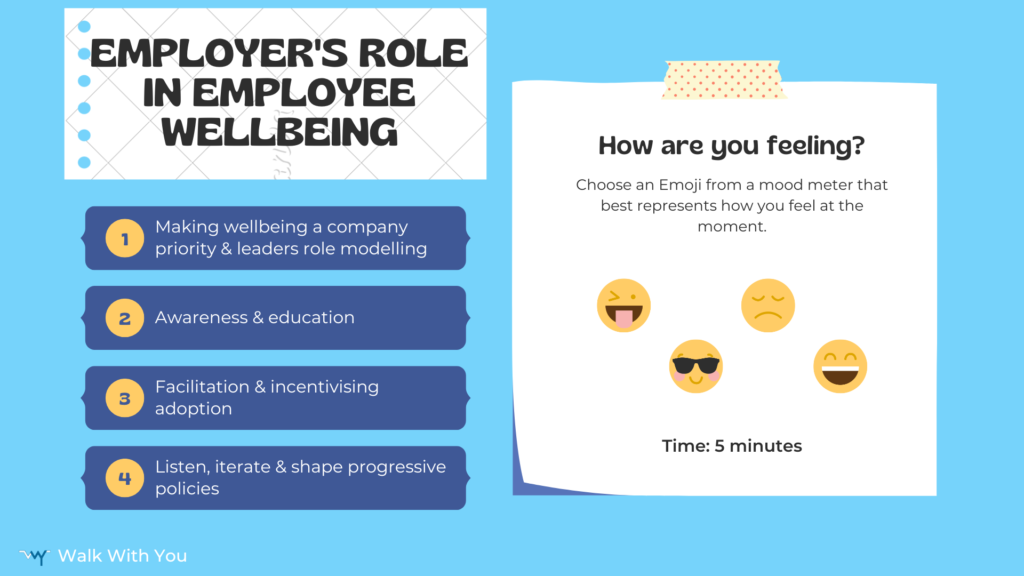The short answer is: well, there’s no definitive answer.
You are allowed to gasp out “What?!” loudly – because after all, we are in 2023 and the short answer should be a confident “YES” end-off, right? But, before you cancel us, hear us out as we articulate employer’s role in employee wellbeing in 2023 & beyond.
Let’s begin with what’s laid out in the Health & Safety laws:

That’s clear guidance. In fact, HSE breaks this down further for employers, calling out their obligations:
- Assess: Identify work activities that could cause injury or illness and taking action to eliminate the hazard, or if this isn’t possible, control the risk.
- Inform & train: Employers must give employees information about the risks in their workplace and how they are protected, also instruct and train them on how to deal with the risks.
- Consult: Employers must consult employees on health and safety issues.
- Educate: Employers have a legal duty under the Health and Safety Information for Employees Regulations (HSIER) to display the approved poster in a prominent position in each workplace or to provide each worker with a copy of the approved leaflet.
- Feedback: Provide satisfactory response to employees if they think their employer is exposing them to risks or is not carrying out their legal duties with regards to health and safety.
The Health & Safety law’s primary objective was to ensure that every worker, permanent or temporary, has access to a safe working environment – very relevant & needed for 20th century workplace, but perhaps sheds limited clarity & guidance for the 21st century future of work.
Post pandemic, increasing number of employees are working from home either full time or for most days of the week. Evolution of the nature of our work & supporting technology has led us to be more sedentary & slouched in front of computer screens for longer periods of time. There is very low safety risk in this workplace environment, but poor posture, high screen time, large periods of inactivity and the lack of true disconnect from work takes a big toll on employee physical & mental health and ultimately their performance.
So what is the role of the employer with regards to employee wellbeing in 2023 and beyond?
Here’s our take on this:
- Make wellbeing a priority and walk the talk: It starts from the top – set promotion of healthy lifestyle & work life balance as a key company value & priority. The next step to amplify the impact across all levels of your organisation is to get leadership to walk the talk. If you set the values, but no one role modelling these values, impact will be limited & short lived. Get buy in from leaders, line managers, department heads to drive impact. Introduce this as a KPI in team meetings, quarterly business reviews – there’ll be push back as wellbeing KPI is often not seen on the same level as hard financial or growth KPIs, but an unhealthy, unsupported org can only be productive for so long…
- Awareness & education: An extension of the above point is to create awareness amongst employees and educate them on various factors that contribute to their wellbeing. A quick win here will be expert webinars, followed by personalised 1:1 sessions that employees can book to seek personalised care.
- Facilitation: Employees are ultimately responsible for their wellbeing, but to go beyond setting right values & awareness, employees can be a catalyst for quicker change by offering or subsidising cost for tools that can help employees get healthier. Examples here are: subsidised gym memberships, organise mental health trainings, app subscriptions.
- Incentivise adoption: Larger organisations find it harder to organically engage a meaningful proportion of employees with culture change. Gamification, incentives go a long way in getting early adoption before network effects kick in within employees leading to wider adoption. Creating champions can also act as an incentive for employees with leadership potential and who are also passionate about wellbeing.
- Feedback & iterate: No one gets it right the first time or even first few times, but the only way to get better at something is to start and then listen to employees and iterate on offering. The best wellbeing program is the one that works for your cohort of employees – it doesn’t have to top of the line, all inclusive, expensive solution, just something that gets your employees educated on wellbeing & engages the workplace community in a meaningful way.
- Shape progressive workplace policies for future of work: Final thing on our list of employer responsibility is helping shape progressive workplace policies. The way we work is changing, the work we do is changing – change being the only constant – and employers play a big role in defining what good looks like for current and future workers. Running progressive experiments, asking for feedback will help shape employee wellbeing programs for 2023 and onwards.
And what’s the employee responsibility here?
Employees are ultimately responsible for their wellbeing. It’s akin to using an accountant to file your taxes, which can inform, help & provide the convenience of filing timely taxes, but the ultimate responsibility that the tax filing is accurate lies with the individual and not the accountant.
In our context, employees should work with employers to create a program that supports them physically, mentally & professionally. If such an employee wellbeing program exists, make the best use of it. Be involved in a regular dialog with your HR & People teams & share what works or doesn’t work for you.

Wrapping up, employer responsibilities regarding employee wellbeing has evolved over the last few decades. Providing a safe environment is table stakes, but good employers not only go above & beyond – but are constantly evolving their employee wellbeing strategy, so as to deliver best impact for their workforce.
Thank you for reading and as always, we’d love to hear your thoughts in the comments section. You can also reach out to us via email.
References:
Read more of our blogs here:



No responses yet